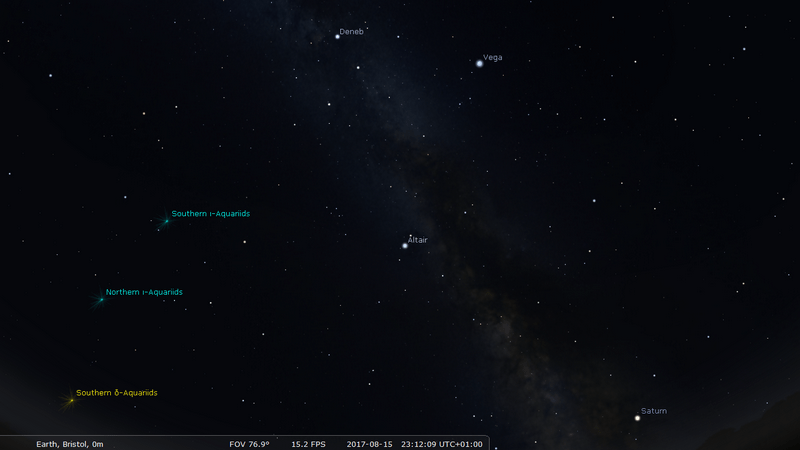The big tickets for August this year are the Perseid meteor shower and for those with flights to the USA, the Solar Eclipse. However, with the skies rapidly darkening again, its a good time to look up with you eyes, binoculars and/or telescope. We start the month with 3 hours of official darkness from 23:45 to 02:45 and by the end of the month that has doubled from 22:00 to 04:15; deep sky objects that were too hard to see over the early Summer months will be within reach again.
The Moon this month is not kind to the Perseid meteor shower as Full Moon is on 7th August and, within a week, the Perseids will hit their annual maximum on 12th August; the Moon will wash out the many of the fireworks as it rises at around 23:00 in the same quadrant of the sky as the radiant of the Perseids. These remnants of comet Swift-Tuttle can theoretically rain down with 60 to 100 observable meteors per hour as it approaches the zenith towards dawn but this year the show is anticipated to give significantly lower counts. Don’t be put off though. The shower picks up from 9th and runs to 13th and the bright ones will be visible a few degrees from the Moon and they’ll be seen over at least half the sky tracing back to the radiant. Look to the north east at about 23:30 and you’ll see a bright star Capella. Look a little further east and up and there is Perseus. The radiant, from where the meteors appear to eminate if you trace their paths back, is at the top of the constellation. Another way to find it is to look for the W constellation of Cassiopeia; the radiant is midway between the W and the bright star Capella. The radiant does move in a wide arc from Cassiopeia to Camelopardis but at peak, it is in Perseus, hence the name.

The main act from earlier in the year, Jupiter, is being caught up by the Sun and by 22:00 or so is setting in the West. Saturn is still with us low in the south until 01:00. A spectacular sight although looking through our thick atmosphere at this altitude it is best visually observed at a medium power as it can swim around a lot.
From the middle of the month onwards, the Moon’s effect disappears and old friends Uranus and Neptune are attainable to the south. Uranus is a good challenge with binoculars (it helps if you’ve had a look through a telescope first at low power to understand where it is in relation to background stars) and Neptune will require a telescope of medium aperture.
On the morning of the 19th, Venus is near the crescent Moon before sunrise in Gemini and worth a view. Have a look from 05:00 if you are up.

Mars is still accompanying Mercury close to the Sun but it is beginning to escape it’s clutches and will be an observable object again in the coming months. Mercury is best observed as an evening object in the first week of August.
Although the Americans have claimed the 2017 Solar Eclipse as theirs, a partial eclipse will be observable from the UK with just a few % of the Sun’s disk obscured on the evening of 21st Aug. First contact will be around 19:40 and those few % will be achieved by 20:00 or so. You’ll need a great western horizon as first contact is only 4 degrees above. Do not look at the Sun directly or through unprotected binoculars or telescopes as it WILL damage your eyes permanently. Use solar projection techniques or invest in professional grade filters/cameras. Some online services like www.Slooh.com will be streaming the American event live. You can sign up for free to watch.


The common feature of the skies at this time of year is the Summer Triangle. Made up of Deneb in Cygnus, Vega in Lyra and Altair in Aquila, this asterism points down to the South from overhead at around midnight from the middle of the month. In not so dark places, it makes the Milky Way easier to spot as it runs along the line of Deneb and Altair arcing overhead.

If you’re missing the friendly throng of fellow astronomers, why not pop along to either the South West Astronomy Fair near Sidmouth on 12th August or Solarsphere 2017 near Builth Wells from 11th-14th August.
Happy viewing.

